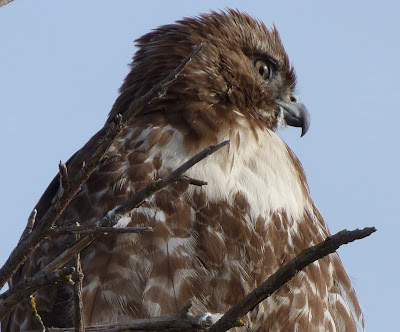Every now and then I get the urge to delete files. I don’t differentiate between necessary and
unnecessary files; as far as I’m concerned all files are necessary, not to be deleted. Some I’m using or have planned
uses for, while others fall into that mysterious category of well-you-can-never-tell-when-I-might-need-that.
Nevertheless, I did click some bytes into the trash this
time, while saving one set of files that I particularly liked. They’re photos of a peregrine falcon at the Sacramento National Wildlife Refuge.
The wildlife refuge is in the Sacramento Valley, which sits
under the Pacific Flyway. The flyway is
used by some 2 million migrating waterfowl that are fleeing winter’s frozen
north for warmer climes. Many of them
glide down from the flyway to spend winter in the valley, on farmland or in
wildlife refuges. The refuges are collections
of ponds and waterways designed for waterfowl--ducks, geese, and swans.
So I had this picture of a bird about which I was curious. I went into the refuge’s headquarters and
asked for the help of a uniformed young woman.
I pointed to a bird in a display case as if to say, that’s it.
“No,” she said. “That
bird has got webbed feet. The bird out
there perches in that same spot every day. It doesn’t have webbed feet. It’s a peregrine falcon.”
She was nice about it.
She could have said, You dummy! Didn’t you look at the feet? This place is for waterfowl. Birds with webbed feet. I had photographed an interloper.
She let me go after telling me the one fact about peregrine
falcons that seemingly everyone latches onto:
They can dive at speeds of 200 miles per hour. Actually, they can go quite a bit faster, as I
learned later.
My education in this instance began with
http://www.10000birds.com/what-is-a-falcon. On this site are essays, photos, and videos “for people who love birds, pictures of birds, and people who write about birds, birding, conservation, and much more.”
http://www.10000birds.com/what-is-a-falcon. On this site are essays, photos, and videos “for people who love birds, pictures of birds, and people who write about birds, birding, conservation, and much more.”
About falcons: “For starters, they have the little notch in
their bill that delivers the killing blow to spinal cords. They have small bony protuberances in their
nostrils that baffle air flow and allow them to breathe while flying at high
speeds. And there are those remarkable
pointed wings, and their reputation for intelligence not shared with the rest
of their former family. These are
special birds.”
But we could have lost them, writes Larry Jordan, in one of
the site’s essays, “Peregrine Falcon–The Fastest Animal on The Planet”:
“This
beautiful raptor was almost driven to extinction from the use of DDT, a popular
pesticide used in the early 20th century….
Beginning in the 1930’s Peregrine Falcon numbers were reduced until in
1970 there were a mere 39 breeding pairs left in the United States….
“The Peregrine Falcon is a success story brought about by
the restrictions placed on the use of DDT, the protection afforded by the
Endangered Species Act, and the reintroduction of captive-bred chicks. A cleaner environment and the success of
cooperative recovery efforts provide great promise of a bright future for the
Peregrine Falcon in North America.”
Jordan’s article also offers a link to High-Velocity Falcon, a National Geographic video. This short video about a skydiving peregrine named Frightful is enlarged on in a Smithsonian Air & Space magazine article, "Falling with the Falcon." These two pieces describe Frightful's high-speed dives. In telling about the dives here, I relied on the Air & Space article.
Frightful was airlifted up to 17,000 feet; she had never been that high before. Not to worry, for she was with her owner and skydiving partner, master falconer and pilot Ken Franklin; also part of the team was Norman Kent, a world-renowned skydiving videographer.
She was released from the plane; Franklin and Kent followed her out. She dove after a lure, streamlining herself by tucking in wings and feet. An altimeter-computer combination measured how far she fell over a certain time. On that dive she was clocked at 183 miles per hour. On another dive a week later, she achieved a velocity of 242 miles per hour.
Frightful was airlifted up to 17,000 feet; she had never been that high before. Not to worry, for she was with her owner and skydiving partner, master falconer and pilot Ken Franklin; also part of the team was Norman Kent, a world-renowned skydiving videographer.
She was released from the plane; Franklin and Kent followed her out. She dove after a lure, streamlining herself by tucking in wings and feet. An altimeter-computer combination measured how far she fell over a certain time. On that dive she was clocked at 183 miles per hour. On another dive a week later, she achieved a velocity of 242 miles per hour.
 |
Peregrine falcons primarily eat birds. That dietary preference tends to upset people who don't like to think about one bird feasting on another. Well, you can't mess with Mother Nature--whatever works, works.
***

No comments:
Post a Comment